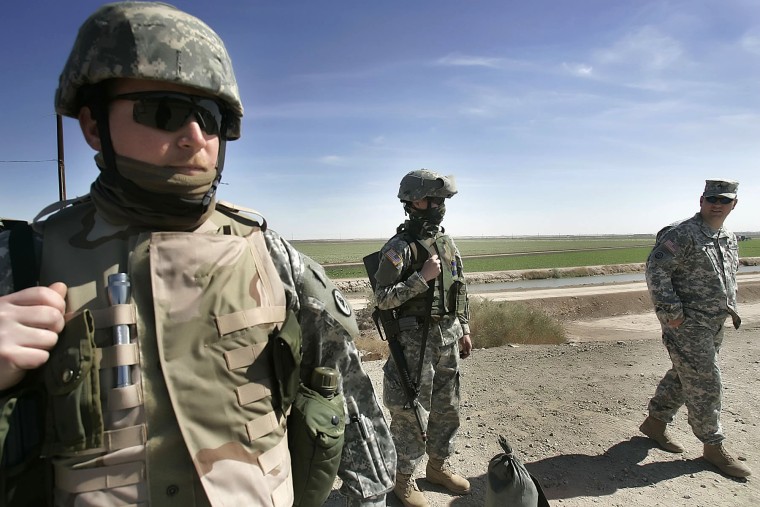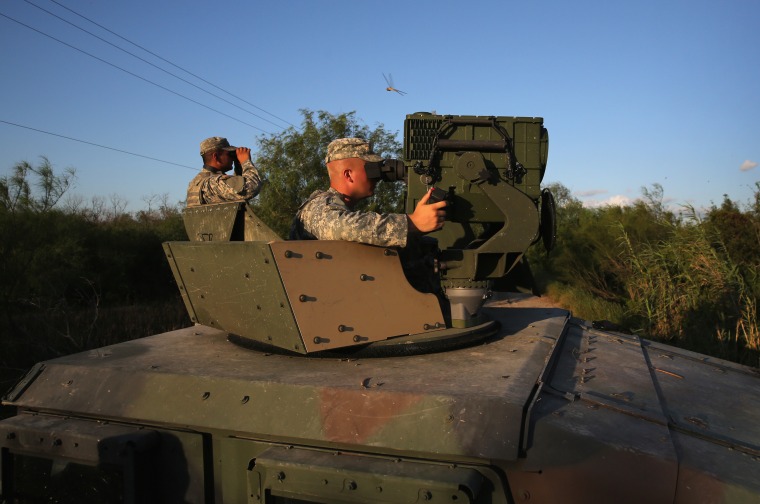WASHINGTON — President Donald Trump signed a proclamation Wednesday directing National Guard troops to the U.S.-Mexico border to fight illegal immigration, but it is not likely to allow the troops to have physical contact with immigrants, according to three administration officials.
The Department of Homeland Security officially announced the policy in a statement Wednesday afternoon.
“To secure the border and make America safe, we need to deploy the National Guard,” said the statement from the office of the homeland security press secretary. "Deploying the National Guard will serve as an immediate deterrent while dramatically enhancing operational control of the U.S. border."
The statement said that the deployment would be in coordination with governors, that the troops would "support federal law enforcement personnel, including [Customs and Border Protection]," and that federal immigration authorities "will direct enforcement efforts."
The White House issued a statement that Trump had signed the proclamation later Wednesday.
The planning follows an announcement by President Donald Trump on Tuesday that came as a surprise to many of his advisers.
"Until we can have a wall and proper security, we are going to be guarding our border with the military," Trump said on Tuesday.
The plans were laid out in a meeting with senior level DHS officials as well as in a meeting with the White House's National Security Council on Wednesday, according to the three officials. The exact number of troops and how long they will be deployed to the border will be solidified in the coming days, the officials said.
DHS Secretary Kirstjen Nielsen called on Congress to tighten loopholes in the immigration system, which she said has made it impossible for the Trump administration to end the so-called catch and release practice whereby immigrants are released from detention while awaiting a trial.
Attorney General Jeff Sessions said Wednesday that the Justice Department "fully supports the efforts of the Department of Defense and Homeland Security announced today to secure our border."
"I will soon be announcing additional Department of Justice initiatives to restore legality to the southern border," said Sessions.
He said it was "essential" for Congress to pass "clear, fair and effective legislation that ends the illegality and creates a system that serves the national interest."
No physical contact
The National Guard troops will not have physical contact with immigrants nor will they be responsible for processing them at the border, one of the officials said. Instead, they will be giving customs agents more visibility by providing surveillance by air and through camera monitoring of the border.
President George W. Bush issued a similar policy in 2006, called Operation Jump Start, though a White House official said it is not yet clear how closely the new deployment will mimic that plan.
President Barack Obama also deployed National Guard troops to the border in 2010 to help provide surveillance by air.

Under Operation Jump Start, approximately 6,000 National Guard troops played a support role to customs agents already in the region by aiding in intelligence gathering and the construction of a fence along the border. The National Guard was not involved in apprehending immigrants or using any kind of force against them, unless they were first attacked.
Apprehensions at the U.S.-Mexico border have begun to increase in 2018, up from 23,555 in February 2017 to 36,695 in February 2018, the latest month for which statistics are available.
Illegal immigration drastically slowed in the first months of the Trump administration, following sharp rhetoric he used to address the issue on the campaign trail. The increase in recent months has led the president to lash out on Twitter, claiming that caravans of immigrants crossing the border must be stopped and refusing to renew a DACA deal, which would protect immigrants previously brought to the United States as children.
Senior administration officials told reporters on Monday that the administration also plans to send legislation to Congress that will make it harder for immigrants to seek asylum and allow the government to detain those apprehended for longer than current federal court decisions allow.
